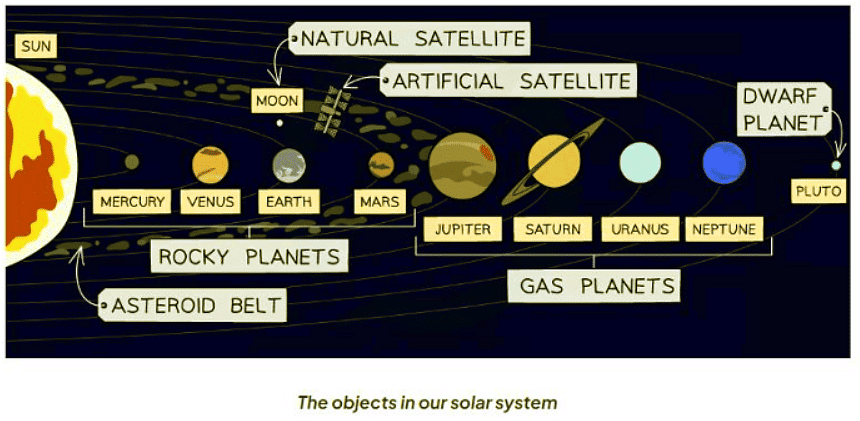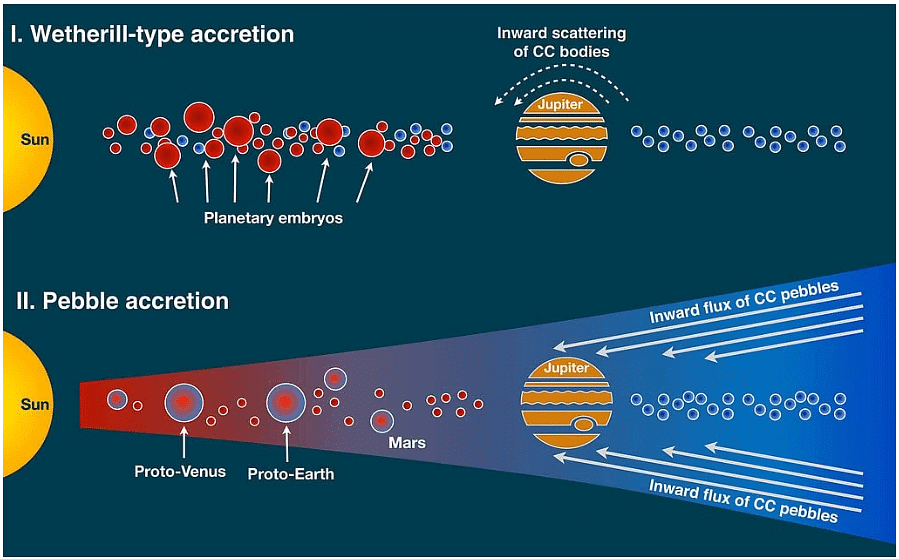Class 10 Exam > Class 10 Notes > Physics for GCSE/IGCSE > The Solar System
The Solar System | Physics for GCSE/IGCSE - Class 10 PDF Download
Introduction
- The Solar System Overview:
- The Sun
- Eight planets
- Natural and artificial satellites
- Dwarf planets
- Asteroids and comets
- The Sun:
- The Sun is located at the center of the Solar System.
- It is a star that accounts for over 99% of the solar system's mass.
- Star:
- A star is a luminous sphere of plasma held together by its own gravity.
- Stars like the Sun emit light and heat due to nuclear reactions in their cores.
Planets and Dwarf Planets
- There are eight planets and an unknown number of dwarf planets orbiting the Sun. Planets have a strong gravitational field that pulls in nearby objects, excluding natural satellites. In contrast, dwarf planets lack a strong gravitational field to attract nearby objects.
- The 8 planets in our Solar System, listed in order of increasing distance from the Sun, are:
- Mercury
- Venus
- Earth
- Mars
- Jupiter
- Saturn
- Uranus
- Neptune
Main Characteristics
- Gravitational Field: Planets have a strong gravitational field that attracts nearby objects, except for natural satellites.
- Dwarf Planets: These celestial bodies do not possess a strong gravitational field to pull in nearby objects.
Satellites
- There are two types of satellites:
- Natural Satellites
- Artificial Satellites
- Natural Satellites
- Some planets have moons that orbit them, such as Earth. Moons are natural satellites.
- Moons are celestial bodies that orbit planets. For example, Earth's moon is a natural satellite.
- Artificial Satellites
- Artificial satellites are human-made objects that orbit celestial bodies. For instance, the International Space Station (ISS) orbits Earth and is a notable artificial satellite.
- Asteroids and Comets
- Asteroids and comets are celestial bodies that orbit the sun.
- An asteroid, a small rocky object, orbits the Sun. The asteroid belt is located between Mars and Jupiter.
Our Solar System
- The region between Mars and Jupiter hosts the asteroid belt, a collection of rocky objects.
- Comets, composed of dust and ice, follow distinct orbits around the Sun, developing tails as they approach.
- Planetary mnemonic: "My Very Excellent Mother Just Served Us Noodles" helps recall the order of the 8 planets.
Asteroid Belt
- The asteroid belt, found between Mars and Jupiter, comprises numerous rocky remnants.
- These objects vary in size and composition, ranging from small rocky fragments to larger bodies.
- Some asteroids possess irregular shapes due to collisions and gravitational interactions.
Comets
- Comets consist of a combination of dust and ice, distinct from the rocky asteroids in the asteroid belt.
- As comets approach the Sun, the ice within them begins to melt, leading to the formation of a visible tail.
- Comet tails, often gaseous and illuminated by sunlight, can stretch for millions of kilometers.
Planetary Mnemonic
- The mnemonic "My Very Excellent Mother Just Served Us Noodles" aids in remembering the sequence of the planets.
- The first letters of each word correspond to the planets in order: Mercury, Venus, Earth, Mars, Jupiter, Saturn, Uranus, Neptune.
- This mnemonic simplifies the process of recalling the planetary order for educational purposes.

Question for The Solar SystemTry yourself: Which celestial body has a strong gravitational field that attracts nearby objects, excluding natural satellites?View Solution
Accretion Model of the Solar System
- There are four rocky and small planets: Mercury, Venus, Earth, and Mars. These are the nearest to the Sun.
- There are four gaseous and large planets: Jupiter, Saturn, Uranus, and Neptune. They are the farthest from the sun.

- The differences in the types of planets are determined by the accretion model, which describes the formation of the Solar System.
- The Sun and the Solar System were created approximately 4.5 billion years ago.
- Planets formed from the remaining matter in a disc-shaped cloud surrounding the young Sun.
- Interstellar clouds contained various elements produced by the end of a star's life cycle.
- Gravity caused the nebula to collapse, leading to the formation of a spinning disc.
- Particles within the disc were drawn together by gravity, gradually forming planets.
- The Sun originated from the gravitational collapse of hydrogen clouds known as nebulae.
- Gravitational forces pulled these clouds together, initiating the formation process.
- As the nebula collapsed, it began to rotate around its center, eventually forming the Sun.
- Particles joined together due to gravitational attraction, initiating an accretion process.
- A rotating accretion disc was formed during the emergence of planets.

- The Sun's growth led to higher temperatures, affecting the formation of inner planets.
- Inner planets consist of materials with high melting points like iron, due to the high temperatures near the Sun.
- The inner planets, like Earth and Mars, are primarily composed of materials with high melting temperatures, such as metals like iron.
- Due to the limited heavy elements in the original nebula (only 1%), the inner rocky planets could not grow significantly, remaining small, solid, and rocky.
- In contrast, the outer planets, such as Jupiter and Saturn, formed in cooler regions farther from the Sun. Here, temperatures were low enough for light molecules to exist in a solid state.
- The outer planets were able to grow much larger than the inner planets, incorporating even the lightest element, Hydrogen. These planets are characterized by their large, gaseous, and cold nature.
The document The Solar System | Physics for GCSE/IGCSE - Class 10 is a part of the Class 10 Course Physics for GCSE/IGCSE.
All you need of Class 10 at this link: Class 10
|
126 videos|182 docs|35 tests
|
FAQs on The Solar System - Physics for GCSE/IGCSE - Class 10
| 1. What is the accretion model of the Solar System? |  |
Ans. The accretion model of the Solar System explains how planets and dwarf planets were formed from a rotating disk of gas and dust around the young Sun. Over time, these particles collided and stuck together, gradually forming larger and larger bodies until planets and dwarf planets were formed.
| 2. How do planets and dwarf planets differ in the Solar System? |  |
Ans. Planets are larger bodies that orbit the Sun, have cleared their orbits of other debris, and have enough gravity to assume a nearly round shape. Dwarf planets, on the other hand, are smaller than planets, have not cleared their orbits of debris, and may not have a spherical shape.
| 3. What role do planets and dwarf planets play in the Solar System? |  |
Ans. Planets and dwarf planets play a crucial role in the Solar System by influencing the orbits of other celestial bodies, shaping the structure of the system, and contributing to the overall dynamics of the system through their gravitational interactions.
| 4. How many planets and dwarf planets are currently recognized in the Solar System? |  |
Ans. As of now, there are 8 recognized planets in the Solar System, including Mercury, Venus, Earth, Mars, Jupiter, Saturn, Uranus, and Neptune. Additionally, there are 5 recognized dwarf planets, including Pluto, Eris, Haumea, Makemake, and Ceres.
| 5. What are some key characteristics of the planets and dwarf planets in the Solar System? |  |
Ans. Planets are characterized by their size, composition, orbit around the Sun, and ability to clear their orbits of other debris. Dwarf planets, on the other hand, are smaller in size, may not have cleared their orbits, and have distinct features that set them apart from planets.
Related Searches















